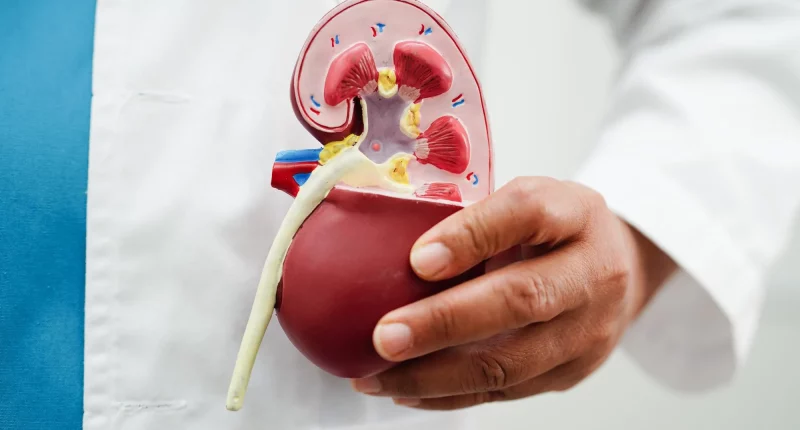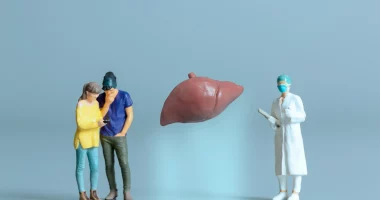Angiomyolipoma is a kind of lump that can grow in the kidney. It’s not cancer, but it’s made up of muscle, fat, and blood vessels. Sometimes, it can make you feel pain and other problems. If it’s causing too much trouble, the doctor might take it out.
Usually, angiomyolipomas don’t make you feel sick and don’t need treatment. But sometimes, they can cause pain in your side, blood in your urine, infections in your urine system, or even make your kidney stop working. Sometimes, they can even bleed a lot and become very dangerous.
Doctors might call them renal angiomyolipomas too.
What is Angiomyolipoma
Angiomyolipoma is a kind of tumor that can develop in the kidney. Most of the time, it’s not cancerous. These lumps are made up of strange mixes of fat, muscle cells, and blood vessels. They are quite common among non-cancerous kidney lumps.
Usually, these lumps just happen randomly and aren’t passed down from family members. They’re found in about 0.44% of people without any family history of them.
Sometimes, though, these lumps can be linked to a rare condition called tuberous sclerosis complex (TSC). This condition causes lots of non-cancerous lumps to grow in different parts of the body.
TSC usually happens because of changes in certain genes called TSC1 or TSC2. These genes normally tell the body to make proteins called tuberin and hamartin, which help stop tumors from growing. However, if these genes change, it can lead to angiomyolipomas forming in the kidneys.
Symptoms
When someone finds out they have angiomyolipoma, they usually don’t feel any symptoms.
But sometimes, in less than 15% of cases, it can cause serious bleeding inside the kidney, which can be very dangerous. This bleeding might make about 1 in 3 people feel shocked.
Other possible signs that someone might have angiomyolipoma include:
- Pain in the side of the body (called flank pain)
- Seeing blood in their urine
- Feeling weak because they have low levels of red blood cells (called anemia)
- Getting infections in their pee system (called UTI)
- Feeling a lump or something unusual in their belly
- Having problems with their kidneys so they don’t work right anymore.
Diagnosis
Doctors usually find angiomyolipomas by accident when they’re checking the kidneys for other reasons, like if someone has blood in their urine or if the doctor thinks there might be a kidney stone. These lumps have a certain look that doctors recognize, so they might not need to do more tests to be sure.
But if the doctor wants to check the lump more, they can use different pictures of the inside of the body. They might use CT scans, MRI scans, and ultrasound to look closely at the lump and see if it’s an angiomyolipoma or something else.
Some other kinds of lumps that might look like angiomyolipomas are:
- Renal cell carcinoma
- Retroperitoneal liposarcoma
- Wilms tumor
- Oncocytoma
Doctors can usually tell if it’s an angiomyolipoma by checking if there’s fat inside it. This is something that’s usually there in angiomyolipomas but not in renal cell carcinomas. However, in a few cases, about 5%, of angiomyolipomas might not have much fat in them.
Also, doctors can check if there are calcium deposits in the lump. Angiomyolipomas usually don’t have these.
Sometimes, doctors might use a special test called digital subtraction angiography to get more details about the blood vessels around the lump.
Treatment
Most people who are affected with kidney angiomyolipomas, don’t feel any symptoms and don’t need treatment.
But sometimes, the doctor might suggest treatment if:
- They think the lump might be cancerous.
- There’s bleeding inside the lump that makes someone feel really sick.
- There’s a chance the lump might break and bits of it could go into the blood.
- Other problems happen because of the lump.
- The lump is really big.
In some cases, especially if the angiomyolipoma makes someone feel bad, the doctor might suggest:
- A special kind of surgery is called selective renal artery embolization. This is when the doctor puts a tiny tube into the leg and moves it up to the arteries in the kidney. Then, they put tiny bits into the blood vessels around the lump to block them and make the lump smaller.
- A surgery called nephron-sparing surgery. This is when the doctor removes the lump but tries to keep as much of the kidney as they can.
- Another surgery is called complete nephrectomy. This is when the whole kidney is taken out.
- Some special treatments like radiofrequency or cryoablation. These treatments use very cold or very hot temperatures to destroy the lump.
- Taking medicines called mTOR inhibitors. These can help people with a condition called TSC handle their angiomyolipomas.
If someone is pregnant and they have a lump bigger than 4 cm, they might get treatment even if they don’t feel sick yet. This kind of treatment is called prophylactic, and it’s done to stop a disease from getting worse.
Risk factors
Most of the time, in about 8 out of 10 cases, angiomyolipomas happen as single lumps, and they’re more common in women who are middle-aged.
But in about 2 out of 10 cases, they happen because of inherited conditions like TSC or LAM. These are things you’re born with.
LAM is a lung disease where muscles grow in the lungs and lymph system.
For Individuals with TSC or LAM, angiomyolipomas can happen to anyone, no matter their gender, and they usually start when they’re younger. These lumps can be more serious. They might be bigger, there might be more than one, and they might happen in both kidneys.
Some things that can make a lump break and go into the blood include:
- Having weak spots in blood vessels (called aneurysm formation)
- Having genes that aren’t normal, like with TSC or LAM
- How big the lump is
- Being pregnant
Outlook
For most people with angiomyolipoma, things are usually okay if they don’t feel any symptoms and the lump isn’t big.
But if the lump starts to bleed, things can be different. Sometimes, people might need urgent treatment to stop the bleeding.
Summary
Angiomyolipomas are lumps that grow in the kidneys, but they’re usually not cancerous. Most of the time, people don’t feel anything from them, and healthcare providers only find them by accident when they’re checking the kidneys for something else.
Sometimes, though, these lumps can make people feel pain in their side, get infections in their urine system, or see blood in their urine. If this happens, the doctor might suggest treatments like blocking the blood flow to the lump or taking it out with surgery.
Usually, people with angiomyolipomas do okay. But in really rare cases, these lumps can bleed a lot and become very dangerous.









